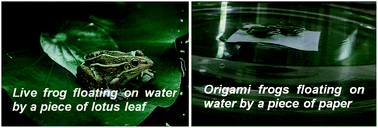Flexible superhydrophobic paper with a large and stable floating capacity†
Abstract
Recently, one interesting wetting phenomenon was found whereby a live frog can stably stand or easily jump on a floating lotus surface. Inspired by the floating leaf, constructing a lotus-like substrate is important to provide powerful aquatic support. In this article, a flexible and light-weight superhydrophobic paper was successfully fabricated by coating a mixture of polystyrene-poly(methyl methacrylate) copolymer (PS-co-PMMA) and silica nano-particles. The micro/nano structures from the composite coating render common papers to possess superhydrophobic surfaces with low adhesion. The coated paper restricts capillary absorption owing to its high water-repellency; moreover, it has an ultra-low absorption when completely soaked into water. A lotus-like support model with some origami frogs is made to display the floating feasibility of the coated paper. The maximum supporting force of the coated paper with an area of 30 × 30 mm is equivalent to ∼68 times its own weight. The simple force analysis illustrates that the great carrying capacity of the coated paper comes from its superhydrophobicity. Importantly, the flexibility of the coated paper possibly gives rise to its good dynamic floating stability. We believe that flexible superhydrophobic paper can be practically applied to some smart designs like aquatic micro-devices.



 Please wait while we load your content...
Please wait while we load your content...